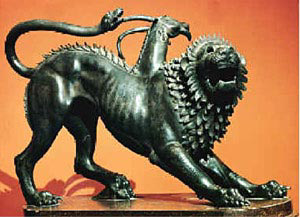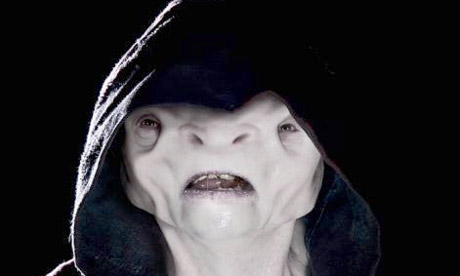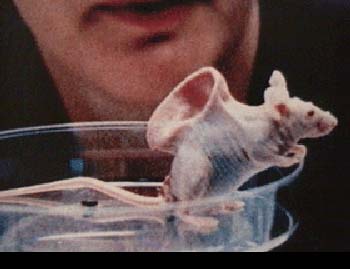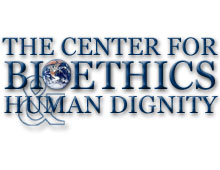The world has gone insane! I read
the other day that mad scientists have produced genetically modified
MONSTER ANTS in the
laboratory. How about genetically-modified
MUTANT MOSQUITOES?
It's open-season on
DNA. What concerned Americans feared in 2005 is already a shocking
reality today!!!
Now it's chimera monkeys made from
the genetic cells of
SIX DIFFERENT ANIMALS!!! Why not 12 or how about 100? The above monkey
may look like a normal monkey, but it's far, far from it. Genetically, you
are looking at 6 different animals. For all we know, human DNA may be in
there too. Who would know? It's going to happen. I assure you, with a weary
soul, that you will see spider-humans in the years to come. Mad scientists
cannot help but delve into the unknown. Do you really think that the world's
wickedest scientists aren't experimenting with humans and animals in hidden
research centers? Of course they are! Man's curiosity is overwhelming!
It is sinful to produce chimeras.
“Chimeras” (named after the fire-breathing creature in Greek mythology
composed of parts of multiple animals) are organisms made up of cells from
two or more genetically distinct sources. God never intended for humans and
animals to be genetically merged to create monsters. In Genesis 1:21 and 24
we read that God in His wisdom created everything to reproduce...
AFTER HIS KIND and AFTER THEIR KIND! Mankind has been
trying to find the alleged “MISSING LINK” (that is, the link connecting
ape-like cavemen with modern man). The link doesn't exist, which is why it's
called “missing.” God created humanity at approximately 4,000 B.C., which
secular history solidly confirms.
The missing link is bad science at
its worse. It appears that arrogant men are hellbent determined on proving
their missing link theory, if if they have to create such monstrosities in
the laboratory themselves. Chimeras are monsters, an abomination in the eyes
of God. God forbid that men should ever succeed in creating a
half-man/half-gorilla creature, having a human spirit and yet the features
of animals. I believe we will see this abomination in the near future if the
Lord Jesus Christ does not return soon.
There are no recorded
civilizations prior to that time period. Egypt is the oldest record
civilization, when people were still writing on stone (hieroglyphics). Both
Biblical and secular history confirm this truth. The Assyrian empire ruled
the world after Egypt, then Babylon after Assyria... followed by
Medo-Persia, Greece and finally Rome. There are many super-powers in the
world today, but no nation has ruled the whole world since Rome. The New
World Order will be the next World Power from which the Antichrist will
arise (Revelation 17:9-11). I get excited every time I read this passage of
Scripture, because it clearly reveals that we are living in the End Times.
We have knowledge and understanding today of Bible prophecy that Christians
throughout history would have given anything to have. We are so blessed by
God! We are living in exciting and frightening times of Biblical prophecy!!!
Even so, come, Lord Jesus!

There Twins Roku
and Hex, whose respective names come from the Japanese and Greek for
‘six,’ have been created with genetic material from six monkeys. They will
likely undergo many torturous experiments.
Researchers from Oregon Health
and Science University in the U.S. extracted cells from six macaque
embryos and combined them into a single embryo in a laboratory before
implanting it into a surrogate mother monkey. In Jurassic Park 3, Dr. Grant
is asked, “Is this where they make the dinosaurs?” Grant replies, “No, this
is where they play God!” Inter species breeding is of the Devil, because it
is impossible in nature. Horse can mate with zebras, because they are within
the same species. Albeit, dogs cannot mate with cats, nor spiders with
goats, because they are two entirely different species. God help us, because
mad scientists are now producing inter-species creatures!!!
Believe me, if evil men can create
a Jurassic Park, they will try! If they can create a monstrosity like
The Island of Doctor Moreau, they certain
will (and I believe they already have)! I personally don't believe that
scientists will need to find dinosaur DNA to make a dinosaur-like monster.
Look at the Monster Ants in the earlier link provided. What if they do that
to an anaconda snake or a gorilla?
Roku and Hex are the world’s first
chimeric monkeys. It was in the news in 2005 that crazy scientists were
injecting human DNA into monkeys. This has
opened a nightmarish Pandora's Box of ethics questions and concerns. The
Bible plainly teaches that the flesh of man is different from the flesh of
animals, birds or fish (1st Corinthians 15:39). God only knows the insanity
that we are entering into in these Last Days of the world.
Genetic Scientists
Create Freakish Monster Ants with Huge Heads and Jaws!
In Minnesota, pigs are
being born with human blood in their veins.
In Nevada, there are sheep
whose livers and hearts are largely human.
In California, mice peer
from their cages with human brain cells firing inside their skulls.
These are not outcasts
from "The Island of Dr. Moreau," the 1896 novel by H. G. Wells in which a rogue
doctor develops creatures that are part animal and part human. They are real
creations of real scientists, stretching the boundaries of stem cell research.
Biologists call these
hybrid animals chimeras, after the mythical Greek creature with a lion's head, a
goat's body and a serpent's tail. They are the products of experiments in which
human stem cells were added to developing animal fetuses.

Photo above: A chimera in Greek mythology
Chimeras are allowing
scientists to watch, for the first time, how nascent human cells and organs
mature and interact -- not in the cold isolation of laboratory dishes but inside
the bodies of living creatures. Some are already revealing deep secrets of human
biology and pointing the way toward new medical treatments.
But with no federal
guidelines in place, an awkward question hovers above the work: How human must a
chimera be before more stringent research rules should kick in?
The National Academy of
Sciences, which advises the federal government, has been studying the issue and
hopes to make recommendations by February. Yet the range of opinions it has
received so far suggests that reaching consensus may be difficult.
During one recent meeting,
scientists disagreed on such basic issues as whether it would be unethical for a
human embryo to begin its development in an animal's womb, and whether a mouse
would be better or worse off with a brain made of human neurons.
"This is an area where we
really need to come to a reasonable consensus," said James Battey, chairman of
the National Institutes of Health's Stem Cell Task Force. "We need to establish
some kind of guidelines as to what the scientific community ought to do and
ought not to do."
Beyond Twins
and Moms

Photo to
right: A fictional character from a movie. One can only imagine what kind of
monstrosities will appear in this world over the years to come due to man's
insane desire to play God.
Chimeras (ki-MER-ahs) —
meaning mixtures of two or more individuals in a single body — are not
inherently unnatural. Most twins carry at least a few cells from the sibling
with whom they shared a womb, and most mothers carry in their blood at least a
few cells from each child they have born.
Recipients of organ
transplants are also chimeras, as are the many people whose defective heart
valves have been replaced with those from pigs or cows. And scientists for years
have added human genes to bacteria and even to farm animals -- feats of genetic
engineering that allow those critters to make human proteins such as insulin for
use as medicines.
"Chimeras are not as
strange and alien as at first blush they seem," said Henry Greely, a law
professor and ethicist at Stanford University who has reviewed proposals to
create human-mouse chimeras there.
But chimerism becomes a
more sensitive topic when it involves growing entire human organs inside
animals. And it becomes especially sensitive when it deals in brain cells, the
building blocks of the organ credited with making humans human.
In experiments like those,
Greely told the academy last month, "there is a nontrivial risk of conferring
some significant aspects of humanity" on the animal.
Greely and his colleagues
did not conclude that such experiments should never be done. Indeed, he and many
other philosophers have been wrestling with the question of why so many people
believe it is wrong to breach the species barrier.
Does the repugnance
reflect an understanding of an important natural law? Or is it just another
cultural bias, like the once widespread rejection of interracial marriage?
Many turn to the Bible's
repeated invocation that animals should multiply "after their kind" as evidence
that such experiments are wrong. Others, however, have concluded that the core
problem is not necessarily the creation of chimeras but rather the way they are
likely to be treated.
Imagine, said Robert
Streiffer, a professor of philosophy and bioethics at the University of
Wisconsin, a human-chimpanzee chimera endowed with speech and an enhanced
potential to learn -- what some have called a "humanzee."
"There's a knee-jerk
reaction that enhancing the moral status of an animal is bad," Streiffer said.
"But if you did it, and you gave it the protections it deserves, how could the
animal complain?"
Unfortunately, said
Harvard political philosopher Michael J. Sandel, speaking last fall at a meeting
of the President's Council on Bioethics, such protections are unlikely.
"Chances are we would make
them perform menial jobs or dangerous jobs," Sandel said. "That would be an
objection."
A Research
Breakthrough
 The potential power of
chimeras as research tools became clear about a decade ago in a series of
dramatic experiments by Evan Balaban, now at McGill University in Montreal.
Balaban took small sections of brain from developing quails and transplanted
them into the developing brains of chickens.
The potential power of
chimeras as research tools became clear about a decade ago in a series of
dramatic experiments by Evan Balaban, now at McGill University in Montreal.
Balaban took small sections of brain from developing quails and transplanted
them into the developing brains of chickens.
The resulting chickens
exhibited vocal trills and head bobs unique to quails, proving that the
transplanted parts of the brain contained the neural circuitry for quail calls.
It also offered astonishing proof that complex behaviors could be transferred
across species.
No one has proposed
similar experiments between, say, humans and apes. But the discovery of human
embryonic stem cells in 1998 allowed researchers to envision related experiments
that might reveal a lot about how embryos grow.
The cells, found in
5-day-old human embryos, multiply prolifically and -- unlike adult cells -- have
the potential to turn into any of the body's 200 or so cell types.
Scientists hope to
cultivate them in laboratory dishes and grow replacement tissues for patients.
But with those applications years away, the cells are gaining in popularity for
basic research.
The most radical
experiment, still not conducted, would be to inject human stem cells into an
animal embryo and then transfer that chimeric embryo into an animal's womb.
Scientists suspect the proliferating human cells would spread throughout the
animal embryo as it matured into a fetus and integrate themselves into every
organ.
Such "humanized" animals
could have countless uses. They would almost certainly provide better ways to
test a new drug's efficacy and toxicity, for example, than the ordinary mice
typically used today.
But few scientists are
eager to do that experiment. The risk, they say, is that some human cells will
find their way to the developing testes or ovaries, where they might grow into
human sperm and eggs. If two such chimeras -- say, mice -- were to mate, a human
embryo might form, trapped in a mouse.
Not everyone agrees that
this would be a terrible result.
"What would be so
dreadful?" asked Ann McLaren, a renowned developmental biologist at the
University of Cambridge in England. After all, she said, no human embryo could
develop successfully in a mouse womb. It would simply die, she told the academy.
No harm done.
But others disagree -- if
only out of fear of a public backlash.
"Certainly you'd get a
negative response from people to have a human embryo trying to grow in the wrong
place," said Cynthia B. Cohen, a senior research fellow at Georgetown
University's Kennedy Institute of Ethics and a member of Canada's Stem Cell
Oversight Committee, which supported a ban on such experiments there.
How Human?
But what about experiments
in which scientists add human stem cells not to an animal embryo but to an
animal fetus, which has already made its eggs and sperm? Then the only question
is how human a creature one dares to make.
In one ongoing set of
experiments, Jeffrey L. Platt at the Mayo Clinic in Rochester, Minn., has
created human-pig chimeras by adding human-blood-forming stem cells to pig
fetuses. The resulting pigs have both pig and human blood in their vessels. And
it's not just pig blood cells being swept along with human blood cells; some of
the cells themselves have merged, creating hybrids.
It is important to have
learned that human and pig cells can fuse, Platt said, because he and others
have been considering transplanting modified pig organs into people and have
been wondering if that might pose a risk of pig viruses getting into patient's
cells. Now scientists know the risk is real, he said, because the viruses may
gain access when the two cells fuse.
In other experiments led
by Esmail Zanjani, chairman of animal biotechnology at the University of Nevada
at Reno, scientists have been adding human stem cells to sheep fetuses. The team
now has sheep whose livers are up to 80 percent human -- and make all the
compounds human livers make.
Zanjani's goal is to make
the humanized livers available to people who need transplants. The sheep
portions will be rejected by the immune system, he predicted, while the human
part will take root.
"I don't see why anyone
would raise objections to our work," Zanjani said in an interview.
Immunity
Advantages
 Perhaps the most ambitious
efforts to make use of chimeras come from Irving Weissman, director of Stanford
University's Institute of Cancer/Stem Cell Biology and Medicine. Weissman helped
make the first mouse with a nearly complete human immune system -- an animal
that has proved invaluable for tests of new drugs against the AIDS virus, which
does not infect conventional mice.
Perhaps the most ambitious
efforts to make use of chimeras come from Irving Weissman, director of Stanford
University's Institute of Cancer/Stem Cell Biology and Medicine. Weissman helped
make the first mouse with a nearly complete human immune system -- an animal
that has proved invaluable for tests of new drugs against the AIDS virus, which
does not infect conventional mice.
More recently his team
injected human neural stem cells into mouse fetuses, creating mice whose brains
are about 1 percent human. By dissecting the mice at various stages, the
researchers were able to see how the added brain cells moved about as they
multiplied and made connections with mouse cells.
Already, he said, they
have learned things they "never would have learned had there been a bioethical
ban."
Now he wants to add human
brain stem cells that have the defects that cause Parkinson's disease, Lou
Gehrig's disease and other brain ailments -- and study how those cells make
connections.
Scientists suspect that
these diseases, though they manifest themselves in adulthood, begin when
something goes wrong early in development. If those errors can be found,
researchers would have a much better chance of designing useful drugs, Weissman
said. And those drugs could be tested in the chimeras in ways not possible in
patients.
Now Weissman says he is
thinking about making chimeric mice whose brains are 100 percent human. He
proposes keeping tabs on the mice as they develop. If the brains look as if they
are taking on a distinctly human architecture -- a development that could hint
at a glimmer of humanness -- they could be killed, he said. If they look as if
they are organizing themselves in a mouse brain architecture, they could be used
for research.
So far this is just a
"thought experiment," Weissman said, but he asked the university's ethics group
for an opinion anyway.
"Everyone said the mice
would be useful," he said. "But no one was sure if it should be done."
SOURCE
END





 The potential power of
chimeras as research tools became clear about a decade ago in a series of
dramatic experiments by Evan Balaban, now at McGill University in Montreal.
Balaban took small sections of brain from developing quails and transplanted
them into the developing brains of chickens.
The potential power of
chimeras as research tools became clear about a decade ago in a series of
dramatic experiments by Evan Balaban, now at McGill University in Montreal.
Balaban took small sections of brain from developing quails and transplanted
them into the developing brains of chickens.  Perhaps the most ambitious
efforts to make use of chimeras come from Irving Weissman, director of Stanford
University's Institute of Cancer/Stem Cell Biology and Medicine. Weissman helped
make the first mouse with a nearly complete human immune system -- an animal
that has proved invaluable for tests of new drugs against the AIDS virus, which
does not infect conventional mice.
Perhaps the most ambitious
efforts to make use of chimeras come from Irving Weissman, director of Stanford
University's Institute of Cancer/Stem Cell Biology and Medicine. Weissman helped
make the first mouse with a nearly complete human immune system -- an animal
that has proved invaluable for tests of new drugs against the AIDS virus, which
does not infect conventional mice. 






